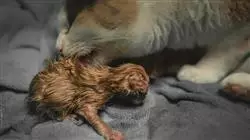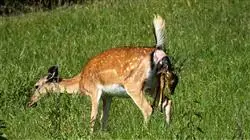University certificate
The world's largest faculty of veterinary medicine”
Introduction to the Program
Veterinarians must continue their training to adapt to new developments in this field”

From the earliest data on animal reproduction in Egyptian hieroglyphs, through to the ancient veterinarians and to the present day, humankind has always been interested in the study of animal reproduction to increase populations and obtain better yields.
Animal reproduction has evolved exponentially in recent decades and its current development means that technologies implemented a few years ago are now obsolete. Combining technique, science and human genius brings results that are identical to natural reproduction.
The Professional master’s degree in Biology and Technology in Mammal Reproduction is developed to expand upon the current knowledge of the physiological and pathological mechanisms of natural reproduction, as well as the specialization in the different techniques of assisted reproduction available for the different species of domestic mammals.
This intensive program includes very new topics in the field of Animal Reproduction, such as sperm sexing in mammals, which are beginning to be applied at a commercial level after years of research. It also covers other topics in genetics that are still under research but are being worked on for inclusion in the current market, such as embryo genotyping by biopsy and CRISPR/CAS. In addition, the teaching team is actively developing the most up to date techniques in assisted reproduction biotechnologies, making the genetic material from different species of international zootechnical interest available to the market.
Don't miss the opportunity to take this Professional master’s degree in Biology and Technology of Reproduction in Mammals with us. It's the perfect opportunity to advance in your career"
This Professional master’s degree in Biology and Technology of Reproduction in Mammals contains the most complete and up-to-date scientific program on the market. The most important features include:
- Case studies presented by experts in Biology and Technology of Reproduction in Mammals
- The graphic, schematic, and practical contents with which they are created, provide scientific and practical information on the disciplines that are essential for professional development
- Latest development in Biology and Technology of Reproduction in Mammals
- Practical exercises where self assessment can be used to improve learning
- Special emphasis on innovative methodologies in Biology and Technology of Reproduction in Mammals
- Theoretical lessons, questions to the expert, debate forums on controversial topics, and individual reflection assignments
- Content that is accessible from any fixed or portable device with an Internet connection
This Professional master’s degree is the best investment you can make when choosing a refresher program to update your knowledge in Biology and Technology of Reproduction in Mammals"
The multimedia content, developed with the latest educational technology, will provide the professional with situated and contextual learning, i.e., a simulated environment that will provide immersive training programmed to learn in real situations.
This program is designed around Problem-Based Learning, whereby the specialist must try to solve the different professional practice situations that arise throughout the program. For this purpose, the professional will be assisted by a novel interactive video system developed by renowned and experienced experts in Mammalian Reproductive Biology and Technology.
This program comes with the best educational material, providing you with a contextual approach that will facilitate your learning"

This 100% online program will allow you to balance your studies with your professional work while increasing your knowledge in this field"
Why study at TECH?
TECH is the world’s largest online university. With an impressive catalog of more than 14,000 university programs available in 11 languages, it is positioned as a leader in employability, with a 99% job placement rate. In addition, it relies on an enormous faculty of more than 6,000 professors of the highest international renown.

Study at the world's largest online university and guarantee your professional success. The future starts at TECH”
The world’s best online university according to FORBES
The prestigious Forbes magazine, specialized in business and finance, has highlighted TECH as “the world's best online university” This is what they have recently stated in an article in their digital edition in which they echo the success story of this institution, “thanks to the academic offer it provides, the selection of its teaching staff, and an innovative learning method aimed at educating the professionals of the future”
A revolutionary study method, a cutting-edge faculty and a practical focus: the key to TECH's success.
The most complete study plans on the university scene
TECH offers the most complete study plans on the university scene, with syllabuses that cover fundamental concepts and, at the same time, the main scientific advances in their specific scientific areas. In addition, these programs are continuously being updated to guarantee students the academic vanguard and the most in-demand professional skills. In this way, the university's qualifications provide its graduates with a significant advantage to propel their careers to success.
TECH offers the most comprehensive and intensive study plans on the current university scene.
A world-class teaching staff
TECH's teaching staff is made up of more than 6,000 professors with the highest international recognition. Professors, researchers and top executives of multinational companies, including Isaiah Covington, performance coach of the Boston Celtics; Magda Romanska, principal investigator at Harvard MetaLAB; Ignacio Wistumba, chairman of the department of translational molecular pathology at MD Anderson Cancer Center; and D.W. Pine, creative director of TIME magazine, among others.
Internationally renowned experts, specialized in different branches of Health, Technology, Communication and Business, form part of the TECH faculty.
A unique learning method
TECH is the first university to use Relearning in all its programs. It is the best online learning methodology, accredited with international teaching quality certifications, provided by prestigious educational agencies. In addition, this disruptive educational model is complemented with the “Case Method”, thereby setting up a unique online teaching strategy. Innovative teaching resources are also implemented, including detailed videos, infographics and interactive summaries.
TECH combines Relearning and the Case Method in all its university programs to guarantee excellent theoretical and practical learning, studying whenever and wherever you want.
The world's largest online university
TECH is the world’s largest online university. We are the largest educational institution, with the best and widest online educational catalog, one hundred percent online and covering the vast majority of areas of knowledge. We offer a large selection of our own degrees and accredited online undergraduate and postgraduate degrees. In total, more than 14,000 university degrees, in eleven different languages, make us the largest educational largest in the world.
TECH has the world's most extensive catalog of academic and official programs, available in more than 11 languages.
Google Premier Partner
The American technology giant has awarded TECH the Google Google Premier Partner badge. This award, which is only available to 3% of the world's companies, highlights the efficient, flexible and tailored experience that this university provides to students. The recognition as a Google Premier Partner not only accredits the maximum rigor, performance and investment in TECH's digital infrastructures, but also places this university as one of the world's leading technology companies.
Google has positioned TECH in the top 3% of the world's most important technology companies by awarding it its Google Premier Partner badge.
The official online university of the NBA
TECH is the official online university of the NBA. Thanks to our agreement with the biggest league in basketball, we offer our students exclusive university programs, as well as a wide variety of educational resources focused on the business of the league and other areas of the sports industry. Each program is made up of a uniquely designed syllabus and features exceptional guest hosts: professionals with a distinguished sports background who will offer their expertise on the most relevant topics.
TECH has been selected by the NBA, the world's top basketball league, as its official online university.
The top-rated university by its students
Students have positioned TECH as the world's top-rated university on the main review websites, with a highest rating of 4.9 out of 5, obtained from more than 1,000 reviews. These results consolidate TECH as the benchmark university institution at an international level, reflecting the excellence and positive impact of its educational model.” reflecting the excellence and positive impact of its educational model.”
TECH is the world’s top-rated university by its students.
Leaders in employability
TECH has managed to become the leading university in employability. 99% of its students obtain jobs in the academic field they have studied, within one year of completing any of the university's programs. A similar number achieve immediate career enhancement. All this thanks to a study methodology that bases its effectiveness on the acquisition of practical skills, which are absolutely necessary for professional development.
99% of TECH graduates find a job within a year of completing their studies.
Professional Master's Degree in Biology and Technology of Reproduction in Mammals
.
The technologies that make it possible to control the reproduction of domestic animals, especially those destined for livestock and food production, require veterinarians with specific knowledge of the most modern and effective techniques in this field. To respond to this professional profile, highly demanded, we have developed a master in animal reproduction that delves into the biological and technological knowledge necessary to control the genetic improvement, fertilization in domestic mammals, the processes of pregnancy and childbirth and the possible complications and difficulties that may arise during them.
Specialízate in Veterinary
.
Companies demand more and more specialized veterinarians, with knowledge focused on the different areas of animal care. To respond to this labor niche and stand out among other veterinarians, it is essential to have a postgraduate course such as this one-year master's degree, which is permanently updated and designed to be taken online.







